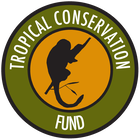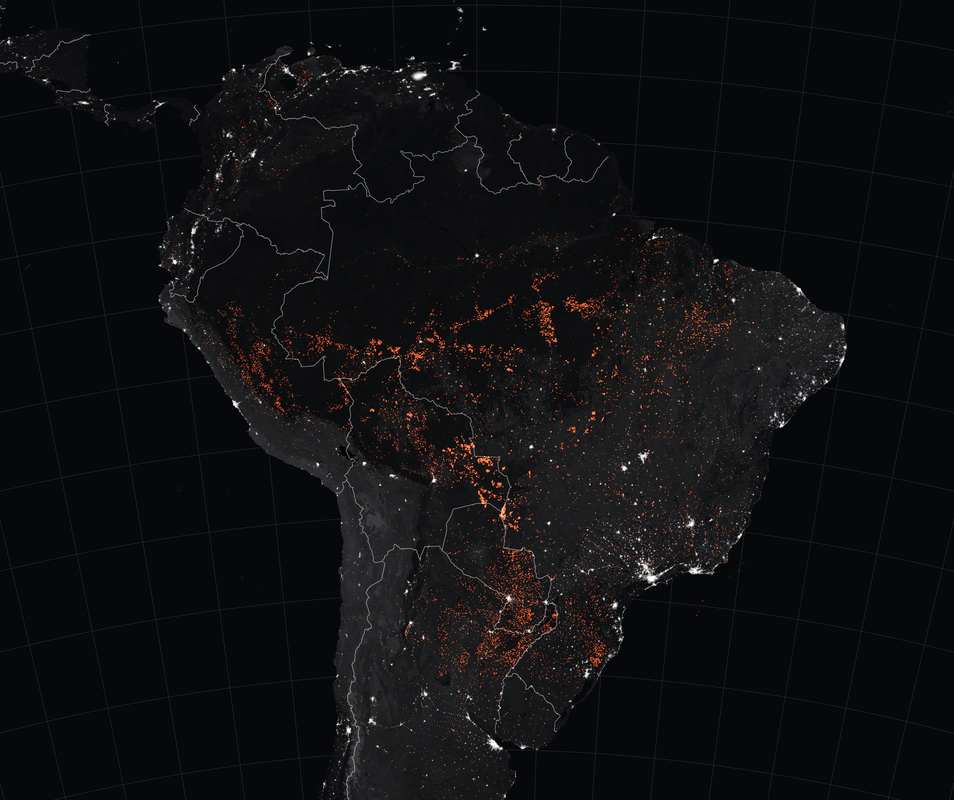The Amazon Basin which makes up 40% of South America has faced numerous threats for the past 40 years. However, the pressures facing the largest tropical wilderness have only grown in the past few years. This is problematic for many reasons, but most notably because it harbors some of the greatest biodiversity in the world, provides untold number of ecological services such as carbon sequestration, clean water and air, and is the home of over 1,000,000 indigenous people representing 400 tribes. Many of these people have never been contacted, and we know very little about their cultures and languages.
Amazon deforestation and wildfires have been raging for decades, resulting in the the loss of 20% of this massive wilderness. However, the problem has only grown in recent years. This year has been particularly dire, with a surge in fires in Brazil, Bolivia, Paraguay, and Peru (see above). One of the largest contributing causes of these wildfires is due to slash-and-burn methods to clear land for agriculture and livestock. Natural wildfires do occur, but in this case over 99% of fires in the Amazon are caused by people. As the name implies, most rainforest will not naturally. Farmers wait for the dry season and they start burning and clearing the areas so that their cattle can graze. In August 2019 alone there were more than 80,000 fires in Brazil, 19,000 in Bolivia, 11,000 in Paraguay, and 6,700 in Peru. This has resulted in the loss of over 9000 km2 (3500m2) just this year.
The 80% increase in deforestation in Brazil this year is largely due to clearing of land for cattle production, which has been encouraged under the leadership of Bolsonaro (Kroger 2019). However, this process has also been fueled in other Amazon nations as a result of agrarian populism in which local and national politicians have undermined years of environmentalism focused on biodiversity and sustainable forest-based livelihoods. As stated by Bolsonaro, "give a gun and a course on how to use it to everyone and let the whole of the Chico Mendes Reserve be deforested to build ranches." The agenda is clear - fuel an uprising against conservationists, environmentalists, and indigenous groups who are working to protect the largest remaining tropical rainforested area in order to fuel an extractive economy. Brazil is not to be solely blamed. Bolivian president Evo Morales also fomented policies that encouraged deforestation. Likewise, across the globe, land is being clear to expand agriculture and cattle ranching, soy production and logging.
Brazilian deforestation is largely a product of demand for beef and soy exports, particularly to China and Hong Kong. Cattle production in Brazil has grown 56% in the past two decades. Unfortunately, much of the land that is being illegally seized is indigenous land which has been occupied for centuries. The situation is extraordinarily similar to the conquest of the Western United States in which murder of indigenous leaders precedes land grab for mining, ranching, and logging (Allen 2019).
The 80% increase in deforestation in Brazil this year is largely due to clearing of land for cattle production, which has been encouraged under the leadership of Bolsonaro (Kroger 2019). However, this process has also been fueled in other Amazon nations as a result of agrarian populism in which local and national politicians have undermined years of environmentalism focused on biodiversity and sustainable forest-based livelihoods. As stated by Bolsonaro, "give a gun and a course on how to use it to everyone and let the whole of the Chico Mendes Reserve be deforested to build ranches." The agenda is clear - fuel an uprising against conservationists, environmentalists, and indigenous groups who are working to protect the largest remaining tropical rainforested area in order to fuel an extractive economy. Brazil is not to be solely blamed. Bolivian president Evo Morales also fomented policies that encouraged deforestation. Likewise, across the globe, land is being clear to expand agriculture and cattle ranching, soy production and logging.
Brazilian deforestation is largely a product of demand for beef and soy exports, particularly to China and Hong Kong. Cattle production in Brazil has grown 56% in the past two decades. Unfortunately, much of the land that is being illegally seized is indigenous land which has been occupied for centuries. The situation is extraordinarily similar to the conquest of the Western United States in which murder of indigenous leaders precedes land grab for mining, ranching, and logging (Allen 2019).
Sources
- Allen, N. (2019). Brazil miners kill tribal leader in Amazon land invasion. Telegraph.
- Butler, R. (2018). Calculating Deforestation Figures for the Amazon. Mongabay.
- Kröger, M. (2019). Deforestation, cattle capitalism and neodevelopmentalism in the Chico Mendes Extractive Reserve, Brazil. The Journal of Peasant Studies, 1-19.
- Margulis, S. (2003). Causes of deforestation of the Brazilian Amazon. The World Bank.
- Phillips, O. L., & Brienen, R. J. (2017). Carbon uptake by mature Amazon forests has mitigated Amazon nations’ carbon emissions. Carbon balance and management, 12(1), 1.

